#types of solar modules
Explore tagged Tumblr posts
Text
0 notes
Video
youtube
The Ultimate Power Bank with Built-in Cables, LED Display, and Mirror Surface
In today's fast-paced world, staying connected is essential. Whether you are traveling, working, or simply on-the-go, having a reliable power bank is a must. Introducing the latest innovation in portable charging technology - the Power Bank with built-in cables, LED Display, and Mirror Surface.
This Power Bank boasts a sleek design with a Mirror Surface and ABS materials, making it both stylish and durable. With a high capacity of 20000mAh, this power bank ensures that your devices stay charged throughout the day.
One of the standout features of this Power Bank is its convenience. It comes with built-in cables, eliminating the need to carry around extra cords. The LED Display allows you to easily monitor the power level, ensuring that you never run out of battery unexpectedly.
In terms of charging capabilities, this Power Bank offers a variety of output interfaces. With double USB ports delivering 5V/2.0A each, you can charge multiple devices simultaneously. Additionally, it features wireless output at 5V/1A, perfect for charging compatible devices without the hassle of cords. The Type-C port with 2A output provides fast and efficient charging for compatible devices.
Safety is paramount when it comes to portable chargers, and this Power Bank excels in that aspect. It supports battery protection, overcharge protection, overvoltage protection, and more, ensuring that your devices are charged safely and efficiently.
Available in classic Black or White colors, this Power Bank is the perfect accessory for anyone in need of reliable and convenient charging on the go. Say goodbye to low battery anxiety and stay connected wherever you are with the Power Bank with built-in cables, LED Display, and Mirror Surface.
#youtube#power bank module#power bank plane#power bank in flight#power bank solar#power bank solar charger#power bank case#power bank camping#power bank charger amazon#power bank jump start#power bank magsafe#power bank mi#power bank magnetic#power bank wireless#power bank yang bagus#power bank xiaomi 20000mah#power bank 5000mah#power bank brands#power bank keychain#power bank portable charger walmart#power bank xiaomi 20000#power bank walmart#power bank type-c#power bank 60000mah
2 notes
·
View notes
Text
Ladder cable tray cover
Ladder cable tray covers from Aparna Rollform are vital for safeguarding cables in industrial and commercial settings.
These covers, made from durable materials like galvanized steel, aluminum, or stainless steel, shield cables from dust, moisture, and mechanical damage, ensuring longevity and safety.
Their robust design supports heavy cable loads while allowing excellent ventilation to prevent overheating. Available in vented, perforated, or solid styles, they balance protection and airflow. Customizable to fit specific sizes and finishes, Aparna Rollform’s covers enhance cable management, simplify maintenance, and improve aesthetics.
Easy to install and corrosion-resistant, they’re ideal for harsh environments. Choose Aparna Rollform for high-quality, reliable ladder cable tray covers tailored to your needs. Visit aparnarollform.com for more.
#Solid Bottom Type Cable Trays#solid bottom cable trays#solid bottom tray#Cable Tray Manufacturer#cable tray manufacturer in Hyderabad#Cable Tray Covers#cable tray cover types#ladder type cable tray with cover#perforated cable tray cover#ladder cable tray cover#perforated cable tray with cover#cable tray manufacturers#cable tray manufacturers in Hyderabad#Raceway Cable Tray Manufacturer in Hyderabad#raceway cable tray#electrical cable tray#cable tray covers#solar module mounting structures#false ceiling sections#stainless steel grating manufacturers#steel reinforcement manufacturers#false ceiling channels types#Types of Ceiling Channels Used In False Ceiling
1 note
·
View note
Text

A Guide to Different Types of PV Modules Unlock the potential of solar energy with our comprehensive guide to various PV modules. From Monocrystalline to Polycrystalline, Bifacial, and beyond, explore the unique characteristics and benefits of each type. Make informed decisions on choosing the right PV module for your solar journey with our insightful guide.
For more: A Guide to Different Types of PV Modules
0 notes
Text
Solar Module Mounting Structures Manufacturers in Hyderabad | Aparna RollForm
Find reliable solar module mounting structures in Hyderabad with the trusted manufacturers. Get high-quality and durable solutions for efficient solar panel installations and maximize your solar energy production.
0 notes
Text
#Global Solar Polysilicon Ingot Wafer Cell Module Market Size#Share#Trends#Growth#Industry Analysis By Type ( Series Connection#Parallel Connection)#By Applications( Solar Power Station#Civilian Solar Small Equipment#Other )#Key Players#Revenue#Future Development & Forecast 2023-2032
0 notes
Text

Okay, guys, here's the plot
Fanfic by Milkyr (thanks @peachyfnaf for editing <3)
Art by CreesA
Reunion
“Eclipse… Promise me one thing before I turn off and you're loaded into your own body..."
"Yes, of course! Anything for you, Sunny."
"No matter what happens… Don't lose yourself."
Gray fingers touched golden ones, and Eclipse looked at Sun. At his beaming smile and pale blue eyes filled with care and slight excitement.
"Whatever that means, I promise."
This was the last time Eclipse saw his Sun happy and alive.
***
Emerging from his own memories, Solar raised his head from the table. He fell asleep on the blueprints again. Grumbling softly to himself, the inventor got to his feet and stretched, hearing his iron joints creak. The animatronic soundlessly walked in soft slippers to the laboratories exit door. Focusing his hearing module on the space beyond the door, Solar listened to the sound of… nothing.
It was pretty quiet here.
Leaving the lab, Solar shoved his hands into the pockets of his lab coat.
"Ruin?"
He called softly, going first into the living room, then into the kitchen, then into one of the bedrooms.
"Eclipse?"
But he wasn't here either.
"Jack?"
It seems that he was completely alone in the bunker.
Solar went through all the rooms once more to make sure that no one was here, and then returned to his lab, blocking the front door and turning on the sound insulation in the room.
He pulled off the worn gray cloth from a capsule, which was located in the depths of the lab and was securely disguised as a "garbage can" so that no one would have the desire to ask questions about what was there. Pushing aside some wooden crates, the mechanic looked at the horizontal capsule with regret in his eyes. Inside, under the glass, laid Sun. But not Sun of whose dimension they now live.
It was his Sun. It was Sunny. The one who was always kind to Solar when he first woke up in someone else's body and didn't understand why he was no longer part of Moon. The one who sacrificed his life in order for Solar to get a chance at his own. The mechanic shook his head, pushing away the obsessive thoughts. His gaze was determined.
He's going to get Sunny back. He will get Sunny back. He's sacrificed too much not to. His fingers quickly tapped on the keyboard of the hidden device in the capsule, and the light inside it lit up. Solar frowned in concentration as he immersed himself in his calculations. He has been working on restoring Sun for several months now- it was very dangerous to work when someone else was in the bunker. His plans could be discovered, so he had to do everything slowly and carefully.
Suddenly, the computer let out an approving beep. The inventor opened his eyes in surprise, looking at the big green check mark on the screen. Did… Did he do it..? Did he really succeed..?
With trembling hands, Solar typed a couple of commands, and a progress bar was displayed on the monitor, gradually filling in black. The mechanic pressed his palms against the glass of the capsule, watching with hope in his eyes as the light inside grew brighter.
“Download complete. All systems stabilized. All external modules running properly. Turn designation: ‘Sunny’ on?”
Solar pressed the confirmation button on the keyboard, staring in fascination as the animatronic in the capsule began to make soft noises. At first it was the crackle of electricity, then the noise of the fans, which became quieter almost immediately as he switched to silent mode.
Sunny opened his eyes.
At first, his eyes were cloudy, he heard only isolated sounds- an incomprehensible buzzing- and felt a heaviness all over his body. He saw a dark blue spot above him.
"Moon..?”
His vision began to clear, and the dark blue spot turned into a dark orange. Who is that? Sunny could say with confidence that this was the first time he’d seen such an animatronic model, but his gaze caught on a couple of details in the appearance, and he gasped.
"Eclipse..?"
Sun spoke with hesitance, still unsure of his assumption.
"Yes."
Solar replied in a quiet, trembling voice, feeling tears running down his cheeks.
"What… What happened?" Sunny asked in surprise, noticing out of the corner of his eye that he was lying in some kind of capsule, a lot of wires were plugged in all over his body. "There must be some mistake here..."
"What do you mean? You're alive, and that's good!"
Solar replied in euphoric disbelief, opening the lid of the capsule. "...You probably didn't understand me," Sunny smiled awkwardly, "the separation should have killed me. I knew I was going to die, but… I wanted to give you the opportunity to live in your own body, live your own life!..

Or..." Sun's gaze suddenly became sad and hesitant. "Or… Or are we both dead and this is the afterlife? Oh no- I'm so sorry- I never meant for this to happe-..."
"-No, no, it's okay! I'm alive, and you're alive too," Solar grabbed Sunny's hand so that he could feel his touch, squeezing it like he would leave him again if he dared to let go, "And I promise I won't let anything happen to you. Never again."
"...Wait!" Sunny suddenly realized something. Attempting to sit up, he rapidly looked around, whipping his head from side-to-side. But Solar restrained him from his attempts, holding Sunny still as carefully disconnected the capsule's wiring so that nothing would be damaged. "W- Where are we? Where’s Moon?!"
"Be careful! Your systems are still very fragile after such a long period of inactivity," the inventor replied, "I'll... I'll explain everything, just let me make sure you can move safely, okay?"
"...Solar, you're making me a little nervous. Where is our brother?"
Sunny asked his question once more, feeling a familiar anxiety slowly creeping up on his mechanisms, making its way under his endoskeleton and stirring the very core of the animatronic. Finally, he was able to sit up and look around. What kind of place is this…
"...Yes. Yes, you did die that day." Solar began with bitterness in his voice, trying not to look into Sunny's eyes as he recounted the memory. "It shocked both Moon and I, and it broke us, and then… And then..." the inventor's voice went tight as a lump formed his throat, forcing him to sound on the verge of tears as he continued.
"...His killcode took over his body. I couldn't save him, Sunny. There was an… accident." He bitterly squeezed out the words. "I'm Sorry, Sun. I'm so, so sorry. Moon is no longer with us."
The final statement hit Sunny like the crack of a painful whip. The whole world trembled right in front of his eyes. Shaking hands clutched at the face plate, despair flooding his features.
"...N-No... nononono, NO! T-This can't… It can't be..." Sun's voice warbled out in despair, "Please, tell me you're lying! T-That this is all a bad joke! PLEASE!"
Before Sunny could lose himself anymore, he felt thin and trembling arms wrap around his back. It was Solar.
Sunny buried his face in Solar's shoulder, shaking and sobbing like a traumatized child. He was absolutely shattered by the news. Moon was his day-one. His other half. His brother. The animatronic he was closest to before they separated and Eclipse appeared.
Gradually, slowly, the sobs in the air began to subside. A numb, pulsating sadness took the place of despair. Sun slightly pulled away from Solar and sighed loudly, causing his fans to flare up for a moment.
"But... What happened then..? H-How are we here?" He asked hollowly, looking at the mechanic.
"I had to conspire with dangerous criminals to survive. Working with them, I at least had a chance to get you back." Solar lowered the tone of his voice, "As of now, my name is no longer Eclipse. My name is Solar."
"Oh my God…" Sunny gasped in fright, taking Solar's face in his hands and looking at his rays. It was only now that he noticed how dirty and broken they were. "D- Did they do this to you? The criminals?!"
"No, no, I'm fine. They won't touch me, we have an… agreement," the inventor shook his head slightly, "But they must not find out about you. We're currently in a bunker under the pizzaplex. This is my lab, and we're in another dimension. But I promise we'll escape from here. I'll find a way.”
"B-But how can they not find out about me if they literally live here?" Sunny shivered, feeling fear creep up his spine. Poor Solar, what kind of mess did he get into..?
"Don't worry, they won't come into my lab. This is my personal space, and no one can come here without my permission." Solar took Sunny's hands in his own once more and looked into his eyes.
"Their names are Ruin and Eclipse. They're both very dangerous- Ruin can infect you with a virus that makes you want to kill, and Eclipse is just out of control when he's not in the mood- and he's always not in the mood. Knowing him, he'll tear you apart as soon as he sees you! Swear to me that you will not leave the lab under any circumstances. Please."
"Solar, I..." Sunny spoke quietly, confused and terrified eyes gazing into the tired and sad ones of the mechanic. "...I trust you. I promise that I will do whatever you say, and help in any way I can."
"Thank you, Sunny. Thank you." Solar leaned forward to hug Sun again, "I'm glad you're back." "Yes..." Sunny hugged the animatronic in response, "I'm so glad to see you, too…"
#villainous trio au#sams au#sams#tsams#tsams au#sun and moon show#sams solar#tsams solar#sams sunny#tsams sunny#sams solar sun#tsams solar sun#vtau info#vtau art#vtau asks#vtau fics
204 notes
·
View notes
Text
Space Station Concepts: Space Operations Center
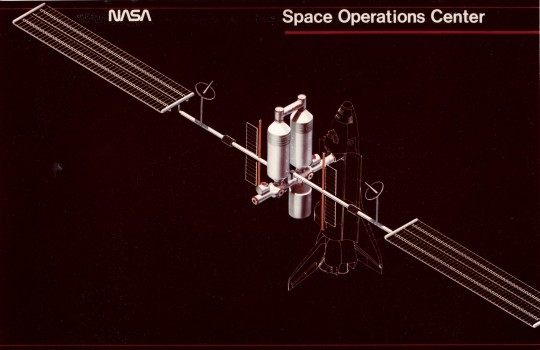

"The SOC is a self-contained orbital facility built up of several Shuttle-launched modules. With resupply, on-orbit refurbish- ment and orbit maintenance, it is capable of continuous operation for an indefinite period. In the nominal operational mode, the SOC is manned continuously, but unmanned operation is possible.
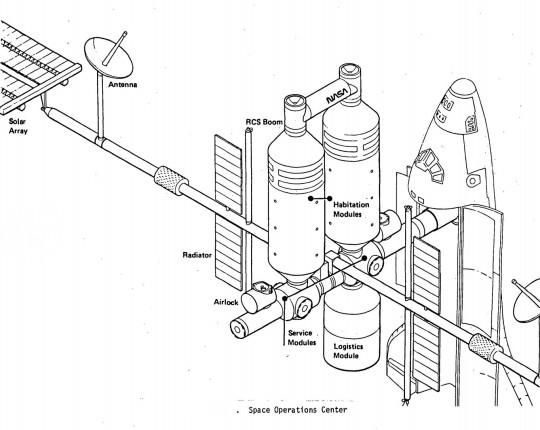
The present mission management and control process is characterized by a people-intensive ground monitoring and control operation involving large supporting ground information and control facilities and a highly- integrated ground-flight crew operation. In order to reduce dependence on Earth monitoring and control, the SOC would have to provide for increased systems monitoring; fault isolation and failure analysis, and the ability to store and call up extensive sets of data to support the onboard control of the vehicle; and the onboard capability for daily mission and other activity planning."
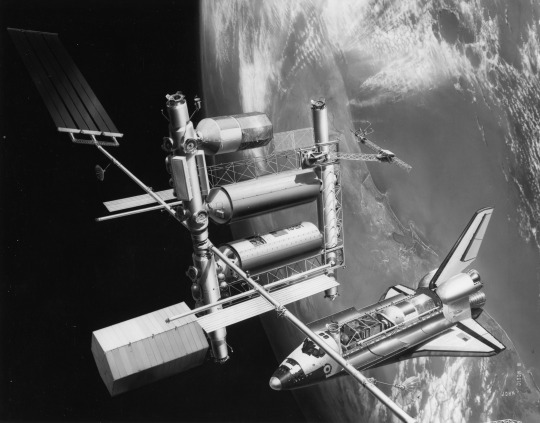
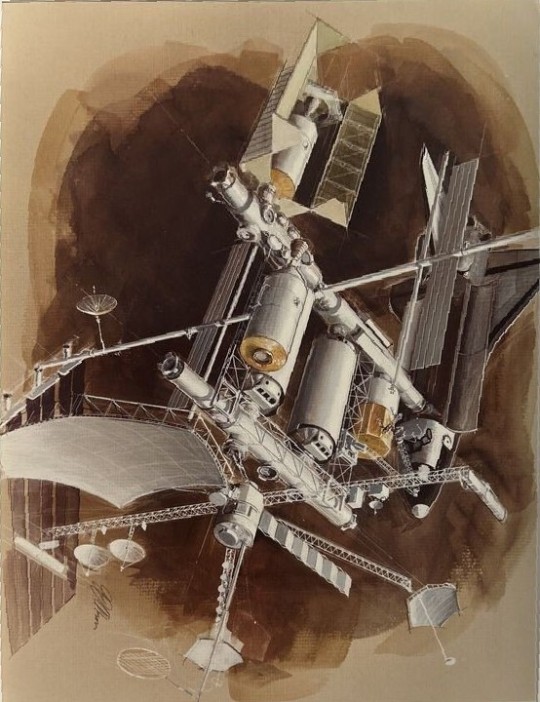
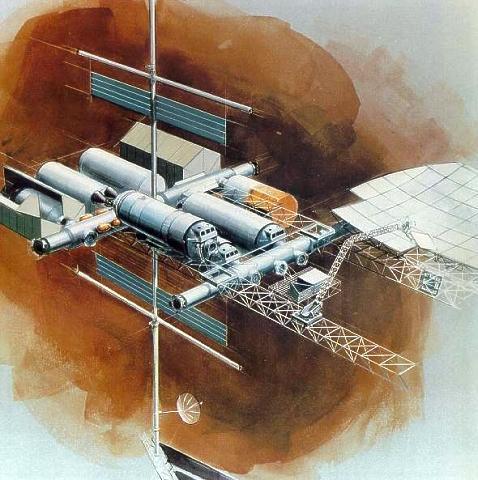
"Like most other space station studies from the mid/late 1970s its primary mission was the assembly and servicing of large spacecraft in Earth orbit -- not science. NASA/JSC signed a contract with Boeing in 1980 to further develop the design. Like most NASA space station plans, SOC would be assembled in orbit from modules launched on the Space Shuttle. The crew's tour of duty would have been 90 days. NASA originally estimated the total cost to be $2.7 billion, but the estimated cost had increased to $4.7 billion by 1981. SOC would have been operational by 1990.
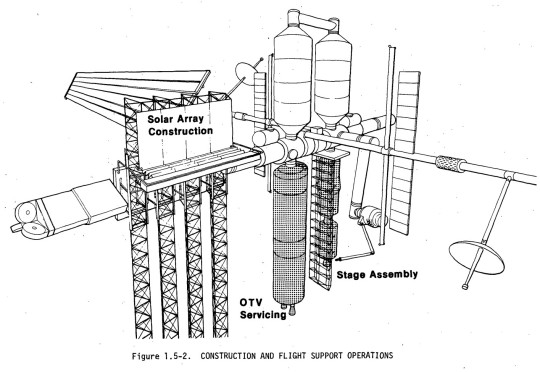
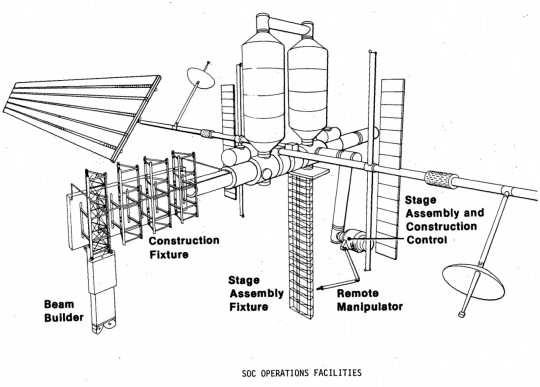

NASA's Johnson Spaceflight Center extended the Boeing contract in February 1982 to study a cheaper, modular, evolutionary approach to assembling the Space Operations Center. An initial power module would consist of solar arrays and radiators. The next launches would have delivered a space tug 'garage', two pressurized crew modules and a logistics module. The completed Space Operations Center also would have contained a satellite servicing and assembly facility and several laboratory modules. Even with this revised approach, however, the cost of the SOC program had grown to $9 billion. Another problem was Space Operations Center's primary mission: spacecraft assembly and servicing. The likely users (commercial satellite operators and telecommunications companies) were not really interested in the kind of large geostationary space platforms proposed by NASA. By 1983, the only enthusiastic users for NASA's space station plans were scientists working in the fields of microgravity research and life sciences. Their needs would dictate future space station design although NASA's 1984 station plans did incorporate a SOC-type spacecraft servicing facility as well."
Article by Marcus Lindroos, from astronautix.com: link

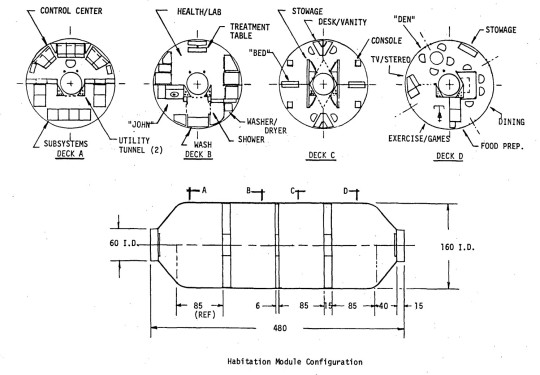


NASA ID: link, S79-10137
Boeing photo no. R-1859, link, link
#Space Operations Center#Space Station Freedom#Space Station Concept#Space Station#Concept Art#Space Station Program#Space#Earth#Space Shuttle#Orbiter#NASA#Space Shuttle Program#1979#1980s#my post
460 notes
·
View notes
Text

BepiColombo's fifth Mercury flyby
On Sunday 1 December 2024, BepiColombo flew past the planet Mercury for the fifth time, readying itself for entering orbit around the solar system's mysterious innermost planet in 2026.
The spacecraft flew between Mercury and the sun, getting to within 37,630 km from the small planet's surface at 15:23 CET. This is much farther than its first four flybys of the planet, when BepiColombo flew as close as 165–240 km from the surface.
What made this flyby special is that it was the first time that BepiColombo's MERTIS instrument was able to observe Mercury. This radiometer and thermal infrared spectrometer will measure how much the planet radiates in infrared light, something that depends on both the temperature and composition of the surface.
This was the first time that any spacecraft measured what Mercury looks like in mid-infrared wavelengths of light (7–14 micrometers). The data that MERTIS will collect throughout the mission will reveal what types of minerals the planet's surface is made of, one of the key Mercury mysteries that BepiColombo is designed to tackle.
BepiColombo's other science instruments will monitor the environment outside Mercury's magnetic field. Among other things, they will measure the continuous (but changeable) stream of particles coming from the sun known as the solar wind.
The other instruments switched on during this flyby are the magnetometers MPO-MAG and MMO-MGF, the MGNS gamma-ray and neutron spectrometer, the SIXS X-ray and particle spectrometer, the MDM dust monitor and the PWI instrument that detects electric fields, plasma waves and radio waves.
BepiColombo, a joint mission between ESA and the Japan Aerospace Exploration Agency (JAXA), will be the second and most complex mission ever to orbit Mercury. It comprises two science orbiters: ESA's Mercury Planetary Orbiter and JAXA's Mercury Magnetospheric Orbiter. While on their way to Mercury, the two orbiters are both attached to the Mercury Transfer Module.
6 notes
·
View notes
Text
Mercedes-Benz is developing a new type of solar paint that could transform electric vehicle power. This photovoltaic coating, just 5 micrometers thick, covers 11 square meters. It can generate enough energy to power a car for up to 7,456 miles (12,000 kilometers) annually under ideal conditions.
The nanoparticle-based paint allows 94% of solar energy to pass through and is easy to recycle. It’s designed to be lightweight (50 grams per square meter) and can cover all exterior vehicle surfaces.
This solar paint, which contains no rare earth elements or silicon, is also cheaper to produce than conventional solar modules. The energy generated can be used to drive the vehicle or feed into the high-voltage battery even when the car is off.
This could mean no need to plug in for charging. The paint can be applied directly to the car’s body, with the color paint job sprayed over it to protect against scratches and other damage.

5 notes
·
View notes
Text
The low budget plan was basically the same as the plan where I didn't need to adhere to a budget; to phase out the existing structure and gradually replace as much of it with rammed earth tire U modules at the ground level.
The second story is meant to be built of superadobe.
The third and any consecutive stories as well as the external frame of the house are supposed to be made of bamboo.
The external facade is supposed to be roofed with ceramic tiles or terra cota and avoid use of concrete as much as possible. Corten steel will cover as much as possible that doesn't affect the temperature regulation of the inside of the house and is about trying to appreciate the generally dry climate here for as long as possible and not about ignoring its large initial carbon footprint. I think it's reasonable to think this could make at least four stable stories on this site that perform significantly better than all surrounding structures on seismic standards and other weathering and aging stresses.
The only factor I didn't work out comfortably enough for my liking was the solar gain and the compromising the neighboring houses will likely impose. If the u modules don't get enough sunlight, they effectively become dead and heat sinks. With a large budget this could be worked around in a number of ways including elevating the ground level with fill soil and compacting properly at least two meters for most of the plot. For that soil to be stable it will need retaining wall type reinforcement mainly on the northern/downslope side. Then on that or embedded within that fill soil a basement level made of stone arches or vaults can be used as the foundation for the U modules. This should add some elevation that doesn't lose solar gain for most of the year, but it's still likely to be compromised. A large vertical mass like a thermal battery spore can be built to compensate at the northwestern corner and be used to also serve as staircase, plumbing, ventilation, and structural spine for upper stories and even if the u modules lose their direct solar gain permanently, the function of the spire spine might compensate on a small footprint to balance the temperature and lighting requirement.
Ugh. I hate this.
2 notes
·
View notes
Text
O Soldier Mine
Young Wolf snarled as he swung his sword against the training dummy. Anger and frustration bubbled beneath his plating as the dummy fell to the snow, burning at the edges from the Solar embedded in the sword. The Hunter swung the blade once more to cut the rest of the dummy’s base down, shoulders rising and falling with his artificial breathing.
“Your rage makes you oblivious to your surroundings.”
Young Wolf snorted, saying nothing as he turned his helmeted gaze to look at Lord Felwinter who stood in the doorway of the training grounds. The Iron Lord was still, staring him down through the ram-like helmet he wore, the soft sound of the taller Exo’s vents opening and closing being the only indication that the man was alive and not a statue. So much different than his student, Osiris. The warlock had told him nothing of what Felwinter was like besides a short few descriptions. The man was… different than Young Wolf had expected.
“You haven’t seen my rage. You’ve seen my frustration and some mild anger,” Young Wolf signed with one hand, slipping his sword back into place on his back.
“Mmm. It still distracts you,” Felwinter hummed as he stepped forward, arms crossed behind him, helmet tilted in observation.
“…….What do you want,” Young Wolf sighed and he signed his next question, turning to face the Iron Lord, very aware of the type of threat the man represented.
“A proposition for you. I’ll spar you, and if you win, we will leave you to your exile in this castle. If I win… you’ll come with us to learn,” Felwinter offered easily, stretching out his hands in a small gesture.
“And a draw,” Young Wolf asked, shifting on his feet, because he had an idea of how the fight would go just based on what he had been told by Osiris and Lord Saladin.
“I suppose we’ll cross that bridge when we get to it,” Felwinter answered with a very light touch of amusement on his time, a sound that was barely there but just detectable.
Young Wolf was silent. He knew it was selfish to want to ask for a single year of peace before he got to saving the system again, but a part of him desired to be selfish for just once. He didn’t want to be a soldier for someone else’s cause any longer. If beating Felwinter would grant him solace for just a bit longer then fine. He’d beat the man and move on.
“Challenge accepted, Iron Lord Felwinter,” Young Wolf said softly, voice modulator crackling static as he used his voice for the first time since making a Wish with Riven.
If Felwinter was surprised, he didn’t show it, and Young Wolf was grateful for it. The Dark Age was weird about Exo Lightbearers for some reason. For Felwinter, Young Wolf may have been his first encounter with another Risen Exo.
“Then I’ll see you at dawn in the field, Warlord,” Felwinter dipped his head in acceptance, seeming just a bit pleased.
“Guardian. Not Warlord. Never Warlord,” Young Wolf replied viper quick, causing the warlock to pause before nodding and taking his leave.
Young Wolf watched him go and sighed softly. Just a single win and he could take a break from everything. Just for a little while. It would be enough.
——————————-
Anyways I’m writing this series in snippets here and there so I don’t overwork myself since it’s a big one! Who loves time travel and YW x O14? I know I do!
You have questions? Ask them!
You have suggestions? Give them!
Wanna know about our YW here? Ask me!
Oh by the way @hidden-scarlet-whispers a snippet for ya
#O Wish-Keeper Mine#destiny 2#new fic series#O14 x YW#Drifter x YW#platonic Cayde x YW#dragonssssss#The Witness#savvy being savvy#felwinter
19 notes
·
View notes
Text
Leading Cable Tray Manufacturer in Hyderabad – Aparna Rollform
When it comes to reliable and high-quality cable tray solutions, Aparna Rollform stands out as a trusted name among cable tray manufacturers in Hyderabad. With years of expertise in metal fabrication and engineering excellence, Aparna Rollform offers durable and customizable cable trays designed to meet the needs of diverse industries, including construction, infrastructure, IT, and manufacturing.
Our range includes perforated cable trays, ladder-type trays, wire mesh trays, and trunking systems—all engineered for maximum load-bearing capacity and corrosion resistance. We use advanced roll forming technology to ensure consistency, precision, and long-lasting performance.
At Aparna Rollform, customer satisfaction is our priority. We provide end-to-end solutions, from design to delivery, ensuring timely project execution and cost efficiency. Whether it’s a small commercial building or a large industrial facility, we deliver cable management systems that are robust, scalable, and compliant with industry standards.
Choose Aparna Rollform – the preferred cable tray manufacturer in Hyderabad. Visit https://aparnarollform.com to explore our products and request a quote today!
#Solid Bottom Type Cable Trays#solid bottom cable trays#solid bottom tray#Cable Tray Manufacturer#cable tray manufacturer in Hyderabad#Cable Tray Covers#cable tray cover types#ladder type cable tray with cover#perforated cable tray cover#ladder cable tray cover#perforated cable tray with cover#cable tray manufacturers#cable tray manufacturers in Hyderabad#Raceway Cable Tray Manufacturer in Hyderabad#raceway cable tray#electrical cable tray#cable tray covers#solar module mounting structures#false ceiling sections#stainless steel grating manufacturers#steel reinforcement manufacturers#false ceiling channels types#Types of Ceiling Channels Used In False Ceiling
1 note
·
View note
Text

Creating a Space Station
Name and Location:
Name of the space station
Orbital location (e.g., around a planet, moon, or in deep space)
Any unique features or characteristics of the location
Background and Purpose:
Brief history and reasons for the station's construction
Primary purpose or mission of the station (e.g., research, colonization, defense, trade, mining, etc.)
Key organizations or entities involved in its establishment
Design and Structure:
Overview of the station's architectural design and layout
Different modules or sections of the station (e.g., living quarters, research labs, docking bays, etc.)
Key engineering feats or technological advancements used in its construction
Size and Population:
Dimensions of the space station (length, width, height)
Estimated population and demographics (humans, aliens, robots, etc.)
Capacity for expansion and accommodating future growth
Systems and Resources:
Life support and Resource systems: Air generation and filtration, Water purification and recycling, Waste management, Artificial gravity, Temperature and air pressure control, Radiation protection, Fire suppression systems, Medical supplies and tools, Food production, Maintenance and Repair tools and facilities
Energy source and storage: Solar power, Nuclear fusion, Advanced batteries, Fusion reactors, Harvesting solar flares
Living Quarters and Facilities
Description of residential areas (individual quarters, communal spaces, recreational facilities)
Water block
Medical facilities and healthcare services available
Education and training facilities for residents and their families
Scientific Research and Laboratories
Different types of laboratories and equipment available depending on the stations’s mission
Astronomical observatories, Biological Laboratory, Climate and Environmental Studies, Planet observation and Research, Rock Analysis Facility
Transportation and Docking:
Docking bays for spacecraft and shuttle services
Transportation systems within the station (elevators, maglev trains, etc.)
Maintenance and repair facilities for visiting spacecraft
Security and Defense:
Security measures and protocols
Defense systems against potential threats: Shielding technology, Defensive satellites & space drones, Cloaking Technology, Countermeasures (flares, countershots, etc), Intruder Detection Systems, Surveillance and AI protection, Protection by AI or Hacker from outside hacks, Self-Repair System
Security personnel and their roles and ranks
Communication and Information Systems:
Communication technology used for inter-station and interstellar communication
Data storage and retrieval systems
Access to networks anddatabases
Trade and Economy:
Types of goods and resources traded on the station
Cargo of the space station
Economic systems
Currency used
Marketplaces within the station
Social and Cultural Aspects:
Societal norms and cultural diversity among the station's residents
Recreational and entertainment facilities (cinemas, sports arenas, etc.)
Events or celebrations unique to the station's culture
Governance and Administration:
Station hierarchy and governing bodies (administrators, council, etc.)
Laws and regulations specific to the station
Interactions with external governing entities (planetary governments, interstellar alliances, etc.)
Exploration and Discovery:
Expeditions or missions launched from the station
Discoveries made during exploration and sample gathering efforts
Spacecrafts and vehicles associated with the station's exploration activities
Environmental Considerations:
Measures taken to mitigate the effects of microgravity or radiation on residents' health
Environmental controls and simulations for recreating gravity and natural environments
Preservation of ecosystems and biodiversity on the station (if applicable)
Emergency Response and Crisis Management:
Protocols for handling emergencies (fires, system failures, medical emergencies, etc.)
Emergency evacuation plans and escape pods
Training programs for emergency response teams
Relations with Other Space Stations or Entities:
Collaborative projects or joint initiatives with other space stations
Trade agreements or diplomatic relations with neighboring stations or colonies
Conflict resolution mechanisms for inter-station disputes
Notable Individuals or Figures:
Prominent leaders from the station
Accomplishments and contributions of notable residents
Astronauts, scientists, or pioneers who have called the station home
Challenges and Risks:
Environmental and technological risks faced by the station
Political and social tensions within the station's community
External threats and conflicts affecting the station's stability
Future Expansion and Development:
Plans for future expansion and upgrades (where are they gonna get the resources for this?)
Integration of new technologies, scientific advancements into the station's infrastructure
Long-term goals for the station
40 notes
·
View notes
Text
Types of PV Modules Made by GREW - Bifacial and Mono Perc
Photovoltaic (PV) modules are the building blocks of solar power systems, and as technology advances, so do the types of PV modules available in the market. GREW, a renowned manufacturer in the solar industry, has been at the forefront of innovation, producing state-of-the-art bifacial and mono PERC modules that have transformed solar installations and solar asset management. In this blog post, we will explore these two types of PV modules made by GREW and delve into their unique features and benefits.

Bifacial PV Modules: A New Horizon in Solar Power
Bifacial PV modules are designed to capture sunlight from both sides, front and rear, effectively increasing energy generation compared to traditional single-sided panels. This innovative design is made possible by using transparent back sheets or dual glass, allowing light to be absorbed from the backside when it reflects off the ground or other surfaces. The increased light absorption leads to higher energy yields, making bifacial modules a popular choice for solar O&M (operations and maintenance) professionals looking to maximize the performance of solar installations.
The key advantage of bifacial modules lies in their ability to harness albedo, which is the reflected light from the Earth's surface. Surfaces like white gravel, snow, or even green grass can reflect significant amounts of light, enhancing the overall efficiency of bifacial panels. This feature is particularly beneficial in regions with high levels of diffuse light or where ground reflection is naturally higher.
Mono PERC PV Modules: Elevating Efficiency and Performance
Mono PERC (Monocrystalline Passivated Emitter and Rear Cell) modules represent a leap forward in solar panel technology. PERC technology enhances the efficiency of standard monocrystalline solar cells by adding a passivation layer on the rear side of the cell. This layer serves multiple functions: it reflects light back into the cell for a second chance at absorption, reduces electron recombination to enhance electrical flow, and allows for more wavelengths of light to be captured.
GREW's mono PERC modules are known for their high efficiency, which translates to more power output per square meter. For homeowners and businesses with limited roof space, these modules are an excellent choice as they can generate more solar power in a smaller area. Solar installation professionals often prefer mono PERC modules for their superior performance in low-light conditions, such as early morning or late afternoon, and their lower degradation rates over time.
Solar Asset Management with Advanced PV Modules
Effective solar asset management is crucial for maintaining the long-term performance and reliability of solar power systems. GREW's bifacial and mono PERC modules offer distinct advantages in this regard. Bifacial modules' ability to generate additional energy can lead to better financial returns on solar investments. This is particularly important for large-scale solar projects where every increment in efficiency can result in significant gains in energy production and revenue.
Mono PERC modules, with their high-efficiency ratings, contribute to reduced operational costs and increased energy yield throughout the lifespan of the solar power system. Their durability and resistance to environmental factors make them a robust choice for solar asset managers who aim to minimize downtime and maintenance expenses.
The Future of Solar O&M with Bifacial and Mono PERC Modules
As the solar industry continues to evolve, the importance of advanced O&M practices cannot be overstated. Bifacial and mono PERC modules from GREW require specialized knowledge and handling to ensure they perform at their peak potential. Solar O&M teams are adapting to these new technologies by employing sophisticated monitoring systems and predictive maintenance strategies. These practices help in identifying potential issues before they escalate, ensuring the longevity and profitability of solar power installations.
In conclusion, GREW's bifacial and mono PERC PV modules represent the cutting edge of solar technology. By embracing these types of PV modules, solar power stakeholders—from installers to asset managers—can reap the benefits of higher energy yields, enhanced efficiency, and robust performance. As solar installations continue to proliferate across the globe, the adoption of such advanced technologies will play a pivotal role in shaping a sustainable and resilient energy future.
For more: Types of PV Modules Made by GREW - Bifacial and Mono Perc
0 notes
Text
From Smartphones to EVs: How the Capacitors Market Is Powering Innovation

Introduction:
The global capacitors market is undergoing a fundamental transformation, driven by the rise of intelligent electronic systems, energy-efficient solutions, and widespread electrification across industrial sectors. As of 2024, the capacitors market is demonstrating consistent and aggressive growth, with forecasts projecting it will exceed USD 47.3 billion by 2032, propelled by a compound annual growth rate (CAGR) of 6.7%. This momentum is attributed to exponential demand in electric vehicles (EVs), renewable energy, consumer electronics, and industrial automation.
Capacitors have become indispensable across sectors, evolving from simple energy storage components to sophisticated modules that ensure voltage stability, signal integrity, and energy efficiency. Emerging economies are fueling demand through infrastructure modernization and industrial digitization, while developed markets are prioritizing high-performance capacitor solutions aligned with environmental regulations and decarbonization goals.
Request Sample Report PDF (including TOC, Graphs & Tables): https://www.statsandresearch.com/request-sample/40592-capacitors-market-analysis
Evolution in Capacitor Types: Ceramic and Supercapacitors Leading Innovation
Ceramic Capacitors Dominating Market Penetration
With their compact size, cost-efficiency, and high-frequency performance, ceramic capacitors are expected to retain the lion’s share of the capacitors market—projected at over 36.4% by 2032. Multi-layer ceramic capacitors (MLCCs) are increasingly favored due to their ability to offer high capacitance in a miniaturized format, especially relevant for 5G devices, IoT modules, and advanced driver-assistance systems (ADAS).
Supercapacitors Revolutionizing Energy Storage
Electric double-layer capacitors (EDLCs) and hybrid supercapacitors are transforming grid storage and transport electrification. Offering ultra-fast charge/discharge cycles and durability far beyond lithium-ion counterparts, supercapacitors are finding increasing use in regenerative braking systems, portable medical devices, and smart grids.
Film capacitors remain essential in high-frequency, high-voltage environments, particularly within renewable inverters and EV drivetrains, whereas electrolytic capacitors retain their stronghold in power supplies, audio systems, and consumer-grade electronics.
Get up to 30%-40% Discount: https://www.statsandresearch.com/check-discount/40592-capacitors-market-analysis
Material Trends: Inorganic Dielectrics Setting Industry Standards
Capacitor performance is intricately tied to dielectric material innovations. Inorganic dielectrics, such as ceramic, mica, and glass, are poised to dominate due to their thermal resilience, chemical stability, and dielectric strength. By 2032, these materials are expected to constitute 43.7% of the market share.
Organic dielectrics continue to be relevant for applications where low cost and moderate thermal tolerance are acceptable, particularly in consumer-grade circuits and compact electronic boards.
Voltage Segmentation: High Voltage Capacitors Fueling Renewable and Industrial Adoption
The high voltage capacitor segment is experiencing the fastest expansion, with a forecasted CAGR of 6.9%. These components are essential in:
HVDC transmission systems
Wind and solar inverters
EV powertrains and fast-charging stations
Grid stabilization and harmonic filtering
This growth is reinforced by global investments in clean energy, modernization of transmission infrastructure, and decarbonization initiatives requiring scalable and resilient capacitor technologies.
Strategic Industry Applications
Consumer Electronics: Miniaturization and Efficiency
Capacitors in smartphones, wearables, AR/VR devices, and smart appliances demand compactness, reliability, and precision. Increasing integration of AI and 5G in devices is accelerating the need for MLCCs that provide high capacitance in tight form factors.
Automotive: Electrification Demands Capacitor Innovation
As EV sales climb globally, capacitors are integral to battery management systems, onboard chargers, and regenerative braking units. High-temperature, vibration-resistant capacitors are critical for vehicle reliability and performance.
Renewable Energy: Enabling Grid-Level Storage
Capacitors stabilize power output and ensure energy smoothing in solar PV arrays and wind farms. Their role in microgrids and hybrid storage systems is pivotal to managing energy intermittency and supporting real-time load balancing.
Industrial and Power Infrastructure
Capacitors are fundamental in automation, robotics, smart factories, and industrial-grade UPS systems, where precise voltage regulation and high reliability are critical.
Regional Insights: Capacitors Market Dynamics by Geography
Asia-Pacific: The Global Growth Engine
Asia-Pacific commands over 42% of the global market, led by manufacturing powerhouses such as China, Japan, South Korea, and Taiwan. Government subsidies for EVs, robust semiconductor ecosystems, and infrastructure investments in countries like India are fortifying the region's dominance.
North America and Europe: Technological Leadership
These regions are driving demand for automotive-grade capacitors, military-spec devices, and green energy solutions. Strong emphasis on compliance, performance, and sustainability makes them vital markets for high-value, specialized capacitor products.
Latin America, Middle East & Africa: Emerging Opportunities
While infrastructure challenges persist, increasing adoption of smart grid technologies, consumer electronics, and industrial automation present untapped growth opportunities in these regions.
Competitive Landscape: Strategic Consolidation and Innovation
Major capacitors market players are aggressively pursuing mergers, acquisitions, and partnerships to consolidate market share and expand technological capabilities. Key developments include:
Murata Manufacturing expanding into high-performance capacitor segments via acquisition.
TDK Corporation investing in automotive-grade high-voltage ceramic capacitors for EV systems.
Samsung Electro-Mechanics focusing on ultra-miniaturized MLCCs for smartphones and wearables.
KEMET innovating in tantalum and polymer hybrid capacitors with high ripple current ratings.
Strategic Focus Areas for Market Leaders:
Advanced dielectric material research
AI-enabled quality assurance systems
Vertical integration in capacitor manufacturing
Eco-friendly manufacturing practices
Expansion of production capacity in emerging regions
Capacitors Market Challenges and Mitigation Strategies:
Regulatory Compliance and Environmental Standards
Stricter regulations on lead content, PCB emissions, and end-of-life recycling are pushing manufacturers to adopt sustainable materials and green production processes.
Counterfeit Products and Quality Assurance
Rising counterfeit capacitor components threaten OEMs. Implementing blockchain-based traceability, laser etching authentication, and AI-driven quality inspection are essential measures to preserve supply chain integrity.
Supply Chain and Raw Material Volatility
Disruptions in rare earth supply chains, especially tantalum and nickel, can jeopardize production timelines. Strategic sourcing, stockpiling, and alternative material development are key hedging strategies.
Future Outlook: Capacitors market Beyond 2030
The capacitors market is set to evolve into a cornerstone of the next-generation digital and green economy. Key transformational trends include:
Quantum computing and edge AI demanding ultra-high frequency capacitors
Flexible electronics integrating printed capacitors on wearable textiles
Energy harvesting systems using micro-supercapacitors in IoT nodes
Next-gen EV platforms requiring ultracompact, ultra-stable capacitors for fast switching
The convergence of miniaturization, sustainability, and electrification will continue to redefine product innovation and market dynamics well into the next decade.
Purchase Exclusive Report: https://www.statsandresearch.com/enquire-before/40592-capacitors-market-analysis
Conclusion
Capacitors are no longer passive components—they are strategic enablers of technological evolution across energy, mobility, and digital infrastructure. Companies that prioritize innovation, scalability, and regulatory readiness will emerge as market leaders in an industry poised for transformational growth. By aligning product development with global megatrends, the capacitors market will continue its upward trajectory and deliver solutions that power the intelligent, electrified, and sustainable world of tomorrow.
Our Services:
On-Demand Reports: https://www.statsandresearch.com/on-demand-reports
Subscription Plans: https://www.statsandresearch.com/subscription-plans
Consulting Services: https://www.statsandresearch.com/consulting-services
ESG Solutions: https://www.statsandresearch.com/esg-solutions
Contact Us:
Stats and Research
Email: [email protected]
Phone: +91 8530698844
Website: https://www.statsandresearch.com
1 note
·
View note